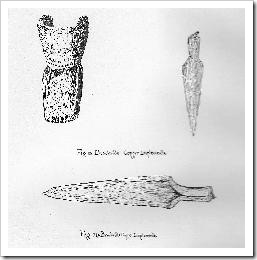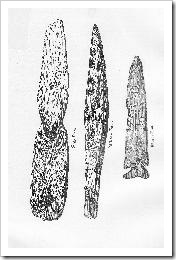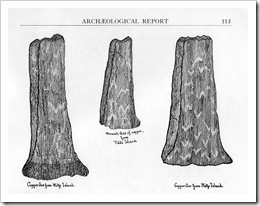|
There are not many official references to archaeology (the branch of anthropology that studies prehistoric people and their cultures) in the Thousand Islands, but there have been discoveries and organized “digs”. Often local residents will discover arrowheads or sherds on their properties and some of those make their way into museum displays.
The following information highlights important works that readers can use to do a more in-depth study.
Jefferson County NY
Timothy Able, director of the Jefferson County Historical Society in Watertown, wrote an excellent introduction to Prehistory of Jefferson County, NY. for the Jefferson County Wiki. He states:
"The first people to enter Jefferson County likely did so from the south, following the glacial beaches left behind by the lakes. They were nomadic hunters and gatherers. Their principal quarry was caribou, which could be taken very easily when intercepted at streams where they were forced to swim. The first people, called Paleoindians, probably date as early as 11,000 years ago, and they left their mark in the form of fluted lanceolate spearpoints, called Parkhill/Barnes points, found at sites within the county. The fact that some of these points have been found as far north as Clayton, demonstrates that they entirely post-date the last of the glacial lakes."
Tremont Island, Ontario
During the early part of the 20th century, Frank Eames, a local Canadian historian, made a concerted effort to research artifacts found on Tremont Island (Tidds Island) near Gananoque in the Admiralty Islands and on Wolfe and Howe Islands in Frontenac County. Eames wrote: "For over fifty years have I consistently sought, begged and bought such aboriginal artifacts as I could obtain, and in behalf of those who presented them to me, I gave credit to the Government Reports; where they are to be observed." Most of his discoveries, known as the Eames Collection, were made in 1910-11 and well described in the annual Archeological Reports published by the Ontario Legislature from 1915-1930. In 1950, Eames published a monograph entitled, "Regional Relics of Primitive Occupation", which describes the many pieces he found.
Gordon Island, Ontario
In 1978 Canada’s National Museum of Man (now the Museum of Civilization in Ottawa) and the St. Lawrence Islands National Park (SLINP) partnered to conduct the 1979 in-depth archaeological survey
1 1979 The Gordon Island North Archaeological Project. Ottawa Archaeologist, Vol. 9, No. 2, p. 2-3. & 1980 Summary of the Results of the Gordon Island North Excavation. Report to the OAS Ottawa Chapter Meeting, February 13, 1980. Ottawa Archaeologist, Vol. 9, No. 7, p. 20-24.
on Gordon Island in. Today Park visitors can learn about the dig on the Island, as SLINP has marked the dig locations and erected interpretive signs.
James V. Wright, responsible for the Government project, explained there were several reasons for conducting the survey in addition to acquiring information on the prehistory of a virtually unknown region. Including “to apply rigorous excavation techniques and full qualitative and quantitative analytical methods of analysis to the relatively thick cultural deposits representing the accumulation of many thousands of years."
Gordon Island, unlike most of the other islands is composed of a sandstone conglomerate rather than the more usual granite of the Canadian Shield. The excavation site was chosen on the northwestern portion of the island in a mature stand of oak trees. Evidently the scientists chose the area as “surface indications and minor probing had indicated the presence of substantial archaeological deposits.”
Reading the summary of the Gordon Island North Excavations we find some important statements:
“The radiocarbon dates and the completion of the faunal, botanical and lithic analysis’s should all provide further insights into the human events that have taken place on Gordon Island over the past 9,000 years.“
“The picture that has emerged to date from the Gordon Island North excavations is one of small bands of people exploiting the island and surrounding resources on a seasonal basis beginning 9,000 years ago and continuing into the historic period. During the 1,500 years between 500 B.C. and A.D. 1000 the island appears to have been incorporated, in a relatively continuous fashion, into the seasonal round of prehistoric peoples. Family groups are involved as suggested by the presence of mature and juvenile pottery vessels. The limited palaeoenvironmental data suggests late summer to fall occupation. It can also be inferred from the location of the site that some form of watercraft was employed; probably the bark canoe. Indeed, the richness of the material culture of these prehistoric peoples is undoubtedly reflected din the most limited way by the few remains that have survived the passage of tie. Of their non-material or intellectual culture we know nothing.”
Much of the material and information found in the “dig” has been used by Parks Canada in their interpretative programs.
Kingston Archaeology
Kingston, being the oldest community in the region has an active interest in excavating. In 2008 the City published a two-volume Archaeological Master Plan — consisting of the Planning Report and Technical Report. These documents provide the most comprehensive history of the region and should be downloaded and perused.
The report states there are 88 documented archaeological sites within and immediately adjacent to the City boundaries, of which 81 were mapped and entered into the project GIS as a discrete layer. Of these, 80 are registered by the provincial site database (as of December, 2007) and eight are not (e.g., Shoal Tower, Dry Dock Museum). This bodes well for fostering an interest in archaeology and in the end preserving important history in an of the region.
The City Cataraqui Archaeological Research Foundation website provides additional information about archaeology in Kingston and Eastern Ontario. The Foundation's mandate focuses on education and research, and they have a number of programs for all ages and and all archaeology skill levels.
Brockville also has completed archaeology studies and review process. programs to help adopt bylaws to ensure archaeological surveys are made on prior to excavation.
Additional reading:
Eames, Frank, "Briefs Historic and Prehistoric", 1950. Gananoque. (Susan W. Smith, Eames Collection)
1979 The Gordon Island North Archaeological Project. Ottawa Archaeologist, Vol. 9, No. 2, p. 2-3. & 1980 Summary of the Results of the Gordon Island North Excavation. Report to the OAS Ottawa Chapter Meeting, February 13, 1980. Ottawa Archaeologist, Vol. 9, No. 7, p. 20-24.
Spence, Michael W., " A Middle Woodland Burial complex in the St. Lawrence Valley", American Anthropologist, New Series, Vol. 70, No. 3 (Jun., 1968), pp. 634-635
http://www.civilization.ca/cmc/exhibitions/archeo/hnpc/npvol15e.shtml
|
 |
These illustrations appeared in an article written by Frank Eames, "Regional Notes on Specimens of Primitive Copper Craft." P. 108-111, Thirty-fourth Annual Archaeological Report 1923, by Dr. R.B. Orr, for the Legislative Assembly of Ontario.
|
 |
The copper artifact, on the left was found near Halstead's Bay. It looks like a folded socket and could have served as a knife or spear.
|
 |
Frank Eames wrote: "No. 113, in the Report of the late curator of the Provincial Museum, the esteemed Dr. David Boyle, to the Canadian Institute, 1886-87, depicts an axe of copper which was found, with many other sof more than usual interest, on a mound on Tidd's Island."
|
|